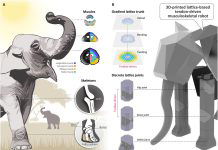
Scientists at EPFL and the Shanghai Institute of Microsystem and Information Technology have made a significant breakthrough in the world of photonics, creating a new type of photonic integrated circuit (PIC) that is both low-cost and highly efficient.
This new development could transform the way optical communications and computing systems are built, making them faster and more accessible.
Photonic integrated circuits are like electronic circuits, but they use light (photons) instead of electrons to carry information.
This makes them incredibly fast and capable of handling vast amounts of data, which is why they’re used in data centers around the world to manage internet traffic.
For many years, these circuits were primarily made from a material called silicon, which was chosen for its cost-effectiveness and compatibility with existing manufacturing technologies.
However, silicon has its limits, particularly in how quickly it can modulate (or switch) optical signals.
Recently, attention has turned to a material called lithium niobate, known for its excellent ability to modulate light quickly thanks to its strong Pockels coefficient—a measure of how well a material can change its optical properties when an electric field is applied.
However, lithium niobate is expensive and difficult to produce, which has limited its use.
Enter lithium tantalate, a material similar to lithium niobate but cheaper and easier to scale up for production. It’s already used widely in telecom industries, particularly in components for 5G networks.
The research team, led by Professor Tobias J. Kippenberg at EPFL and Professor Xin Ou at SIMIT, focused on this material to create their new PIC platform.
The team developed a special process to work with lithium tantalate, involving wafer-bonding—a technique where different layers of materials are fused together. They then used advanced etching techniques to carve out tiny optical pathways and components directly on the lithium tantalate wafer.
This process was key to ensuring the circuits were both efficient and capable of handling the demands of modern communication systems.
One of the standout features of the new PIC is the electro-optic Mach-Zehnder modulator (MZM), an essential component for high-speed data transmission.
The lithium tantalate MZM achieves excellent performance metrics, including a very low voltage requirement for operation and the ability to handle frequencies up to 40 GHz.
Additionally, the researchers were able to generate soliton microcombs on the circuit—arrays of light frequencies that are crucial for applications like LiDAR (a technology used in self-driving cars) and photonic computing.
This new circuit design not only performs well but also supports dense configurations and works across all telecommunications frequency bands, making it a versatile and powerful tool for the future of technology.
With its potential for lower costs and high efficiency, it could soon play a crucial role in making our data centers faster and our internet connections more robust.
Source: KSR.



